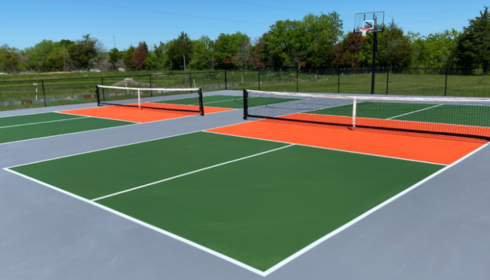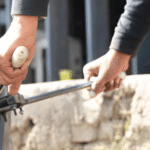Pickleball is no longer just a weekend hobby—it’s now one of the fastest-growing sports worldwide, especially across India’s housing societies, clubs, and schools. As the craze continues, more property developers and sports facility owners are exploring pickleball court construction to attract fitness-minded communities.
However, before taking the plunge, it’s important to understand the cost of pickleball court construction, the right pickleball court size, and what goes into installing a pickleball court that meets international standards.
Understanding Standard Pickleball Court Size
Before any construction begins, knowing the exact pickleball court size is essential for planning layout, space allocation, and base preparation.
According to USA Pickleball Association (USAPA) standards:
- Playing Area: 13.41 meters (44 feet) in length × 6.10 meters (20 feet) in width for both singles and doubles.
- Total Court Area (Including Run-off): 18.29 meters (60 feet) × 10.06 meters (33 feet) for safe player movement.
- Net Height: 91.4 cm (36 inches) at the sidelines and 86.4 cm (34 inches) at the center.
This compact design allows pickleball courts to fit easily in limited spaces—making them ideal for residential projects and multi-sport complexes. Some developers even build combo courts, combining pickleball and tennis on the same surface using color-coded lines.
Key Phases of Pickleball Court Construction
Professional pickleball court construction companies follow a precise, layered approach to ensure long-lasting, high-performance results. Here’s a breakdown of each phase:
- Site Assessment & Design Planning
Engineers evaluate soil condition, slope, and drainage. A slope of 1:100 is maintained for proper water runoff. - Base Preparation
The base is constructed using either asphalt or M20-grade reinforced concrete, depending on the budget and soil type. Compaction and leveling are critical for even ball bounce. - Acrylic Layering
Multiple coats of primer, resurfacer, cushion layers (optional), and pigmented topcoats are applied. These layers form the synthetic system that gives the court its color, grip, and resilience. - Line Marking & Finishing
Once the surface cures, USAPA-standard lines are marked using reflective, high-durability paint. - Optional Add-ons
Fencing, lighting, seating, and drainage channels enhance functionality and aesthetics, particularly for clubs and academies.
Each stage requires technical accuracy, which is why hiring professional pickleball court construction companies ensures quality and long-term performance.
Cost of Pickleball Court Construction
The cost of pickleball court construction depends on several variables — materials, base type, labor, and accessories. Below is a general cost breakdown based on Indian market averages (as of 2025):
| Component | Approx. Cost Range (INR) | Details |
| Base (Concrete/Asphalt) | ₹180 – ₹250 per sq.ft | Includes leveling, slope, and curing |
| Acrylic Layer System | ₹90 – ₹150 per sq.ft | 5-layer to 8-layer cushioned/non-cushioned systems |
| Line Marking | ₹10 – ₹15 per sq.ft | ITF/USAPA-approved reflective paint |
| Fencing | ₹70 – ₹120 per sq.ft | GI chain link fencing with MS poles |
| Lighting Setup | ₹25 – ₹60 per sq.ft | LED floodlights for evening play |
| Accessories (Net, Posts, Seating) | ₹30 – ₹50 per sq.ft | Optional but recommended |
➡ Average Total Cost: ₹4.5 – ₹8 lakh for one standard outdoor court (exclusive of land and civil work).
Costs vary depending on city, surface type, and whether you opt for cushioned acrylic layers or basic hard courts.
Installing a Pickleball Court: DIY vs Professional Approach
Some property owners consider installing a pickleball court as a DIY project, but professional execution is strongly recommended for durability and accuracy.
DIY Limitations:
- Difficulties in achieving proper slope and drainage.
- Inconsistent surface texture leading to poor bounce.
- Shorter lifespan due to incorrect layering or low-grade material use.
Professional Installation Advantages:
- Precision leveling and compaction for perfect ball response.
- Use of ITF-approved, UV-resistant acrylic coatings.
- Controlled curing times for long-term durability.
- Warranty on workmanship and material quality.
By choosing trusted pickleball court construction companies, you ensure your investment delivers lasting performance with minimal maintenance.
Materials Used in Pickleball Court Construction
The type of material used directly impacts cost, comfort, and lifespan. Modern synthetic acrylic systems are preferred worldwide due to their superior properties:
- UV Stability: Prevents color fading and surface hardening under sunlight.
- Non-Slip Texture: Fine silica sand blend offers grip without abrasiveness.
- Cushion Option: Reduces joint stress, perfect for schools and senior players.
- Eco-Friendly Composition: Water-based, non-toxic coatings safe for all environments.
Each layer is designed for a specific purpose—from sealing the base to providing the right bounce and ball speed.
Why Hire Professional Pickleball Court Construction Companies
Searching for pickleball court construction near me brings up countless options, but only experienced builders with a track record in sports flooring can deliver consistent results.
Top-tier companies offer:
- End-to-end project management from design to installation.
- Trained applicators for multi-layer acrylic systems.
- Material warranties and after-sales maintenance.
- Assistance with fencing, lighting, and line marking as per USAPA norms.
Partnering with a certified company ensures your court remains visually appealing, weather-resistant, and performance-ready year after year.
Factors That Influence Pickleball Court Costs
Before finalizing your budget, consider these factors that impact total project expenditure:
- Base Type: Concrete costs more initially but lasts longer than asphalt.
- Surface System: Cushioned systems add comfort but raise material cost.
- Site Conditions: Uneven or water-logged areas require additional civil work.
- Location: Urban labor rates and transportation charges can vary regionally.
- Add-ons: Lights, fencing, and branding elements add visual appeal and usability.
Understanding these factors helps you choose the right configuration for your budget and purpose.
Maintenance & Lifespan
A well-constructed court lasts over a decade with minimal maintenance. Follow these tips for longevity:
- Wash the surface regularly to remove dust and organic buildup.
- Inspect annually for cracks or fading.
- Resurface every 5–7 years to restore color and grip.
- Keep drainage channels clear during monsoons.
Routine upkeep ensures your investment remains vibrant and functional for years to come.
Conclusion
Investing in pickleball court construction is a long-term commitment that enhances community engagement and property value. By understanding the cost of pickleball court construction, proper pickleball court size, and hiring reliable pickleball court construction companies, you can build a facility that delivers professional-grade play for every age group.
Whether you’re setting up a private backyard court or a commercial sports complex, expert guidance in installing a pickleball court guarantees results that last—beautiful, safe, and ready for action.


